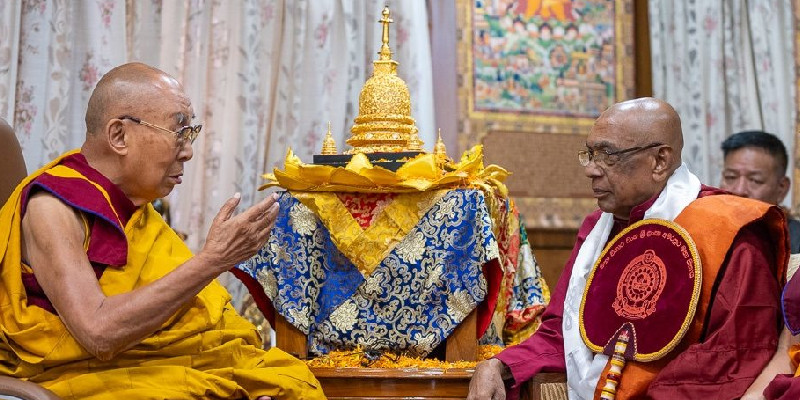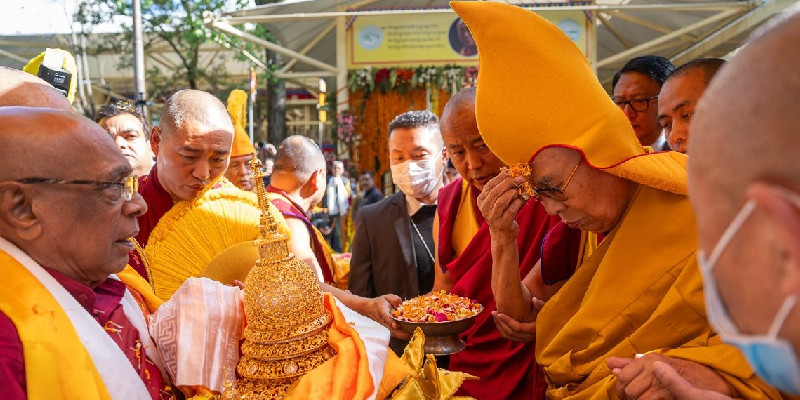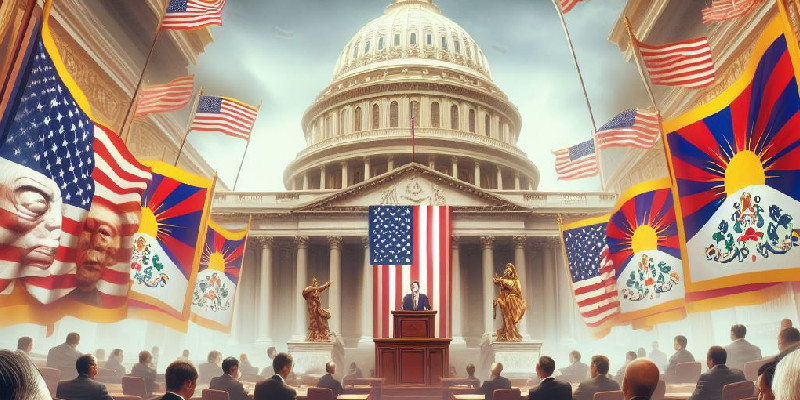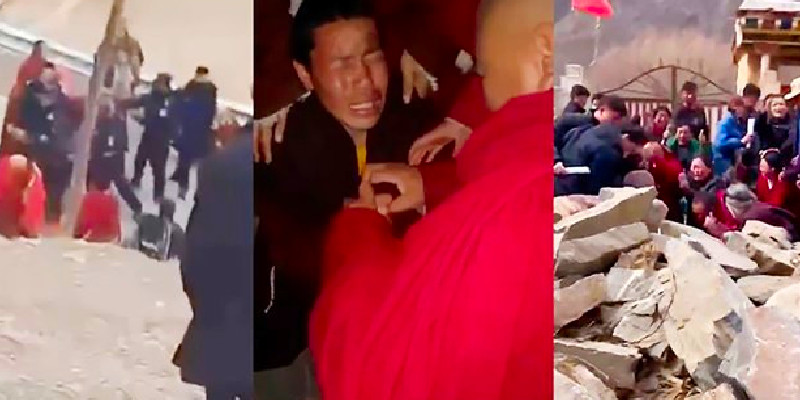From its inception, Tibet has been an independent entity, distinguished by the Tibetan alphabet and language, distinctive culture, geographical landscape, political system, and perhaps most notably by the Tibetan Buddhist religion. However, Tibet’s claim to its territory has been a source of contestation for centuries, with the most recent and arguably most brutal annexation of Tibet deployed by the People’s Republic of China. The precedent of foreign occupation and international relations in Tibet was first defined during the thirteenth century, through the patron-priest relationship established between the Mongol Emperor Kublai Khan of the Yuan Dynasty and Tibetan Buddhist spiritual masters. From the patron-priest relationship, both parties benefitted and coexisted in peace. The current annexation of Tibet by the People’s Republic of China is an attempt to subvert this long paradigm of harmonious coregency in Tibetan affairs into an authoritative foreign dictatorship of Tibetan territory, most clearly demonstrated by the Seventeen-Point Agreement and its aftermath.
The patron-priest relationship between the Mongols and Tibet first established during the thirteenth century was a stable, mutually beneficial co-regency in which a secular Mongol ruler was given religious authority by a Tibetan religious master, who was in turn given political power by the secular Mongol ruler. Specifically, the Tibetan leaders that were given political power during this time were masters of the Sakya school of Buddhism, most notably Sakya Pandita and his nephew Pakpa Lodrö Gyeltsen. While the Mongols were undoubtedly expanding territorial control of the Yuan dynasty by indirectly ruling through the Sakya school, they expertly created a united front with the conquered Tibetans, not only by respecting and adopting their religion and traditions but also by granting them political power they otherwise would not have had. Specifically, the Mongols appointed Tibetan Buddhist monks to govern over Mongol conquered Chinese territory, which resulted in a dramatic rise in Buddhist monasteries and translation of Buddhist texts in Chinese provinces1. Furthermore, the Mongols granted privileges to Tibetan leaders in hopes of easing their rule and promoting their prosperity. In a letter sent by the Yuan imperial court to a Tibetan district under Mongol jurisdiction, the Mongol court grants the monastery of Zhalu in western Tibet exemption from taxes, requisitions, and labor, “According to the Emperor’s command, let there be no quarrels concerning old taxes, old affairs, and old cases. Let religious and lay communities belonging to this territory of Zhalu not be carried off by force, into subjection and slavery”2 . Critically, in exchange for the political authority granted to Tibetan masters, Mongol leaders were granted religious authority. This not only strengthened Tibetan support of the foreign Mongol rule but also served to help the Mongols get in the favor of Tibetan Buddhist spiritual and supernatural entities, which they believed would enhance the prosperity and longevity of the Yuan Dynasty. In the painting “Initiation of Qubilai Khan and Offering Tibet to Phakpa in 1264” (16th – 17th century) displayed in the Rubin Museum of Art, the Sakya lama Pakpa Lodrö Gyeltsen is shown bestowing an esoteric initiation upon Kublai Khan3 (Appendix 1). Phakpa is seated in the center of the painting and is portrayed significantly larger than Kublai Khan, who is seated off to the side of Phakpa. It is Phakpa, rather than Kublai Khan, who sits on the throne of the imperial court that seems to resemble the Mongol emperor’s palace in the capital of the Yuan dynasty, Shangdu. Moreover, Kublai Khan is depicted pressing his palms together to express gratitude and respect towards Phakpa. Through the symbolic use of hand gestures as well as the size and spatial differences between Phakpa and Kublai Khan, the painting is an overt display of Mongol subordination under Tibetan masters with respect to Tibetan Buddhist religious contexts, in which the Mongols not only accepted but promoted Tibetan Buddhist primacy, as doing so only conferred strength and authority back to themselves. The utility of Tibetan Buddhist promotion is demonstrated by the Mongol response to the religious empowerment of Kublai Khan, in which Phakpa was named the religious and secular leader of Tibet and was awarded control over central Tibet and Tsang, as well as Amdo and Kham4. With the formation of the Yuan dynasty in 1271, Phakpa would be appointed as the imperial preceptor in Kublai Khan’s imperial court, such that Kublai Khan could continue receiving religious empowerment. The Mongol-Sakyapa alliance was not only harmonious and mutually beneficial but was also strategically designed such that the continuous and intentional promotion of the opposing party was also a mechanism to increase the legitimacy of their own authority. Importantly, while the Mongol Empire expanded its control into Tibetan territory, the structure of international relations that the Mongols established maintained Tibetan autonomy and jurisdiction such that the lives and wellbeing of the conquered Tibetan people were not greatly affected.
In stark contrast, the present annexation of Tibet by the People’s Republic of China is a forced occupation that has resulted in the persecution and death of millions of Tibetans. The single official document that marks the turning point into the current Tibetan climate is the Seventeen-Point Agreement for the Peaceful Liberation of Tibet. The document was signed in 1951, following the invasion of eastern Kham by the People’s Liberation Army (PLA) from the South-West Military Region, which now consists of the provinces Yunnan and Sichuan, ultimately culminating in the Battle of Chamdo. The lack of unification in eastern Kham, which was not unified with the central Tibetan government under the Dalai Lama but was instead governed by fragmented smaller political entities, failed to pose any meaningful resistance against the PLA. The eastern fragmentation coupled with the outnumbered and amateur Tibetan army proved to be fatal in Chamdo. Importantly, it was under this context of preexisting military occupation of Chamdo, along with failed attempts at securing international intervention on behalf of the United Nations and subsequent threats of Chinese military invasion into remaining Tibetan territory, that Tibet ultimately entered negotiations with the Chinese Communist Party. Unwilling to lose more than the 5,700 men of the 8,000 troops that were lost in the Battle of Chamdo, the Tibetan government had been effectively trapped with no hope of foreign intervention5.
Thereafter, a series of negotiations and opposing proposals began, during which the Tibetan government affirmed their independence and pushed for an extension of the patron-priest relationship that has long been the historical standard of foreign relations between Tibet and China6. The Chinese Communist Party refused to acknowledge or discuss the Tibetan proposal, instead of pushing their own ten-point proposal while simultaneously deploying the People’s Liberation Army troops towards Lhasa, a seeming direct threat towards the Dalai Lama7. Under continued and escalating threats of Tibetan death and destruction, the Tibetan delegates signed the “Agreement of the Central People’s Government and the Local Government of Tibet on Measures for the Peaceful Liberation of Tibet”, or the Seventeen-Point Agreement, which was essentially an extension of the initial ten-point proposal brought by the Chinese. However, the document also includes additional points that were conditioned by the Tibetan delegates, of which most importantly declared that the power and position of the Dalai Lama would be restored to him if he were to escape Tibet and return after four or five years. While the Chinese government agreed to these points brought by the Tibetans, they insisted it is separated from the primary document and kept secret8. To this day, the supplemental document remains undisclosed by the Chinese government, demonstrating an outright rejection of Tibetan participation and requests presented during the negotiations. The dynamic between the Chinese Communist Party and the Tibetan government demonstrated both leading up to and throughout the Seventeen-Point Agreement has been inculcated with Chinese coercion with the sole purpose of acquiring complete Tibetan submission.
The explicit rejection of the Tibetan request to continue the patron-priest relationship reveals the true motivations of the Chinese Communist Party. The patron-priest relationship rested on mutual trust and respect, making a formal agreement unnecessary and thereby demonstrating the true consensual nature of the relationship, in which both parties maintained the alliance without needing the binding force of a written contract. In contrast, the Seventeen-Point Agreement uses contractual force as a guise for consent. The mere language used in the title, the Seventeen-Point “Agreement”, was chosen and designed to convey a semblance of contented, bipartisan endorsement and to invalidate Tibetan opposition for the document. The mutually beneficial cooperation that ensued from the patron-priest relationship demands the existence and recognition of two, distinct, independent entities, that work alongside each other, yet separately, to benefit themselves and the other party. The Chinese refusal to acknowledge Tibetan autonomy, therefore, explains their rejection of the Tibetan proposal for the extension of the patron-priest relationship. In forgoing this relationship, the Chinese also forgo the economic, political, and cultural capital that the Mongols acquired during the Mongol-Sakyapa alliance. Instead, the Chinese opt for a model of forced integration into a single entity, in which only the single entity is allowed to exist and flourish. This ethnocentric approach to foreign relations is further supported again by the Chinese refusal to acknowledge the patron-priest relationship, as the relationship has existed in Tibet since the thirteenth century and has since then become an integral part of Tibetan history and culture. The destruction of this facet of Tibetan culture is a single instance in a larger agenda for the widespread eradication of Tibetan tradition and existence, further demonstrated by the Chinese resettlement to Tibet resulting in a Tibetan minority, the declaration of Chinese as the official language of Tibet and the suppression and decline of Tibetan Buddhism. The Seventeen-Point Agreement serves as the entry point for the ruthless Sinicization of Tibet.
Through the Seventeen-Point Agreement, the Chinese Communist Party undermines the patron-priest relationship of Tibetan foreign affairs. This subversion is both a display of the pervasive Chinese indoctrination of Tibetan authorization of their own annexation as well as the attempted sheer destruction of Tibetan culture and tradition. It is a demonstration of the underlying foundation of Chinese moral principles and standards, in which cultural diversity, mutual altruism, and basic human rights are vehemently suppressed in favor of a single, subservient ethnic identity.
Appendix 1: “Initiation of Qubilai Khan and Offering Tibet to Phakpa in 1264” (16th – 17th century), C2002.3.2, HAR 65046l, Rubin Museum of Art.
Works Cited
Columbia University. n.d. “The Mongols in China, Life in China under Mongol Rule: Religion.”
Accessed December 20, 2021. http://afe.easia.columbia.edu/mongols/china/china3_f.htm
Kapstein, Matthew T., 2006. The Tibetans. Oxford, UK: Blackwell Publishing.
“Promises and Lies: ‘The 17-Point Agreement’” The Tibet Journal, Vol. 36, No. 1 (Spring2011), pp. 27-45. https://www.jstor. https://www.jstor.org/stable/tibetjournal.36.1.27
Rubin Museum of Art. n.d. “Initiation of Qubilai Khan and Offering Tibet to Phakpa in 1264”
(16th-17th Century) C2002.3.2, HAR 65046l.
Accessed December 20, 2021.
Schaeffer, Kurtis R., Kapstein, Matthew T., and Tuttle, Gray. 2013. Sources of Tibetan Tradition. New York: Columbia University Press.
1 Columbia University, n.d.
2 Giuseppe Tucci, Tibetan Painted Scrolls (Rome: Libreria dello Stato, 1949), vol. 2, 671. Sources of Tibetan Tradition 2013: 345.
3 Rubin Museum of Art, n.d. C2002.3.2, HAR 65046l.
4 Kapstein 2006: 112.
5 “Promises and Lies: ‘The 17-Point Agreement’”, 29.
6 “Promises and Lies: ‘The 17-Point Agreement’”, 30-31.
7 “Promises and Lies: ‘The 17-Point Agreement’”, 32-34.
8 “Promises and Lies: ‘The 17-Point Agreement’”, 35-36.






Leave a Reply